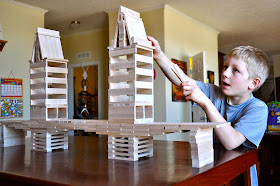The summer before my Junior year in college, long before I ever thought I wanted to homeschool, I spent the summer working at the Christian sports camp, Kanakomo, in Branson, Missouri. I loved the biblical foundations used for instruction at the camp and enjoyed spending time in the Word of God studying and praying. One of the verses that stood out to me the most that summer was:
And Jesus grew in WISDOM, STATURE and in FAVOR with God and men. ~ Luke 2:52
For the first time in my life I began to contemplate Christ as a youth, as a young, divine yet human man growing and maturing within a loving home and a challenging community. Today, it is that very verse that has guides me in the quest for selecting the curriculum, teaching methods, activities, athletics, service work and social endeavors of our school.
The more we become like Christ, the closer we come to understanding and fulfilling God's purpose for our lives. As a homeschooling mother, the #1 goal in developing my sons' intellectual capacities, challenging their creativity, fueling their imagination and forming their souls is so that they can obtain happiness (and freedom) in this life and the next as sons of God.
This post is not a revelation of every little thing we do in our teaching home. You really don't need a play-by-play. There are plenty of other homeschooling blogs out there who are willing to do that, ones you can mimic if you need a prototype for your own school. However, you should know that your classroom will be, and should be, of your own unique design and ambition. I don't have any fancy printables to share with you or mind blowing ideas of how to run a tight ship. But I will share what I consider to be the essentials of building a successful classroom.
(Creative hands-on activities are a wonderful enrichment to our textbook lessons. Andrew builds a bridge out of Keva Planks using the architectural concept of the cantilever.)
Wisdom: Core studies, of course, but also practical application of the knowledge through hands on activities, field trips, experiments and personal inventions. Art, music and cultural studies are also important, and of course our religious studies, which include prayer, scripture memorization, following the liturgical calendar and celebrating special feast days (See my blog list for helpful websites).
Stature: Physical exercise and athletics (the boys choose), healthy eating and good hygiene habits. I love to get them in the kitchen and let them help prepare meals and snacks. They can help menu plan and grocery shop (more school - they just don't know they're learning! We call it "life-skills".)
Favor with God and Men: Nurturing relationships within the home comes first, and homeschooling presents plenty of opportunities to work on cooperation, generosity, forgiveness, humility, patience, etc. Of course the boys also have ample opportunities to engage in healthy relationships with others outside of the home through athletics, music lessons, cooperative classes and church organizations.
(The famous Diet Coke and Menthos experiment! So much fun!)
The question that I receive the most with regards to "How we do it" is about scheduling. Every year is different for us, because every child's needs, learning levels and activities are different. Last year I had a newborn on my hip, so the boys had to be flexible with feedings and diaper changes. But, nevertheless, you do fall into a rhythm that just seems to work.
The 3 C's of Our Classroom:
A focus on commitment, curriculum and consistency helps me to manage the daily modes of our homeschool environment. Commitment = You have to be committed 100%, there's really no in-between. Your kids are counting on you whether they realize it or not. Considering public or private schools for your children only if homeschooling doesn't "work out" with the expectation that the teacher will fill in all of the gaps that occurred due to your lack of planning and/or implementation is unreasonable. I'm just being honest here, not critical. You can fall in love with the idea and ideals of homeschooling, but at the end of the day you still have to be the one who puts them into practice.
Curriculum = There are so many incredible choices out there. Take some time to study the programs, ask questions and consider the needs and abilities of your children. Then, jump in and follow the lesson plans that come with the curriculum. If it's not working, or you are not pleased with one or two subjects, don't be afraid to try something else. There are a lot of teaching ideas online, and it can be overwhelming. Choose a few things and use them well. Sometimes less is more.
Consistency = The greatest ground is gained in academics, attitude and efforts from the kids, when you are consistent. The school day has to be woven into daily life, kind of like an appointment. Some families are able to do bits here and there throughout the day, but for me with that approach it's too difficult to keep the boys focused. We try to keep the morning blocked off just for school. So, am I a fan of schedules? You bet. But, that's not to say that I can't be flexible. You just have to know yourself and your abilities as a teacher, then decide how flexible you want to be.
(We love to take every opportunity possible to move school outdoors!)
What about all the other "stuff" that has to get done?
You've probably heard it said that if you want to get anything done, give the job to the busiest person. To some degree this is very true. My busiest semester in college was filled with 22 credit hours, part time work, marathon training and music rehearsals. Somehow there was still time for friends and volunteer work. You might be surprised how much you can accomplish with just a little re-arranging and adjustments to your normal routine.
When you know that as a mom you will only have a certain amount of time each week to squeeze in doctors' appointments and grocery runs, to read a good book, exercise, catch up on e-mails or socialize with friends, your chore and school time will become very efficient. If you have older children, they can certainly help out with chores, and I'm a big fan of chore charts and rewards at the end of the week for their contributions to the family through care of the home (small rewards such as popcorn and movie night, a special dessert, a field trip, camping out etc.). When kids share in the responsibility of the home and the school, it is a boost to their self-esteem and character formation.
Collectively, our boys ages 4-11 do the following: mow the grass and trim, take out the trash, clean their room, make their beds, put away laundry, set the table, clean up the dishes, empty dishwasher, sweep the floor, detail the family vehicle (as best they can), wipe down bathroom sinks daily, sweep out garage, keep play room tidy, play with Charlie while mom tends to other business.....they really can do so much! The chores are spread out throughout the day, shared among them all and are considered a part of our normal routine, so a very small percentage of the day is dedicated to chores.
(Henry, listening to recorded stories on the Mac while I teach the older boys.)
The juggling act:Teaching several grades at once:
1. We always begin the school day in the same way, with prayer, the Pledge of Allegiance and reading of the saint for the day. Then, depending on our work load, I will review map skills, Spanish/French/Latin vocabulary and any current events or weather news. All grades participate in this.2. Then, the older kids typically have assignments that they can work on on their own, while I work with the younger ones. This might include handwriting, poetry memorization, textbook reading (science and history), or math tutorials on the computer. Their lessons are written on the white board before class begins, so they know what to do.
3. When it is time to work with the older ones, whomever I'm not instructing may teach something simple to the younger ones (tangrams, letter/number recognition etc.) read to them, or practice their instruments.
4. We usually being school at 8:30, and take a 20 minute mid-morning break for recess. Recess has to be filled with physical activity, because for boys especially, it helps their mental focus, motivation to learn and allows them to get all of their crazy bugs out before entering back into the classroom. I use the recess time to grab another cup of coffee, prepare for science labs, grade papers, photocopy tests or set out a few hands on activities for the little ones to work on/play with.
5. Our school day typically ends around 12:30 p.m. Afternoon time is dedicated to quiet reading, unfinished work, art and/or music practice. Typically, this is only an hour or so.
(Salt dough relief maps ~ part of our study on geographical landforms)
Many families choose, for a variety of reasons, to homeschool year round. While there are many benefits to that approach, it does not fit our family lifestyle. I like to have a concentrated time to accomplish the year's curriculum goals, then spend the summer "unschooling." Gardening, farming, raising 4-H animals, cooking, crafting and traveling are all educational, without being quite so scheduled or desk-oriented. You will quickly see that one of the fruits of homeschooling is that your eyes, heart and mind are open to the possibility of everything being a teaching opportunity, whether it's grocery shopping, going to the dentist or volunteering in the community.







Great post, Susan! Thank you for sharing! You are awesome. I wish you lived closer!
ReplyDelete